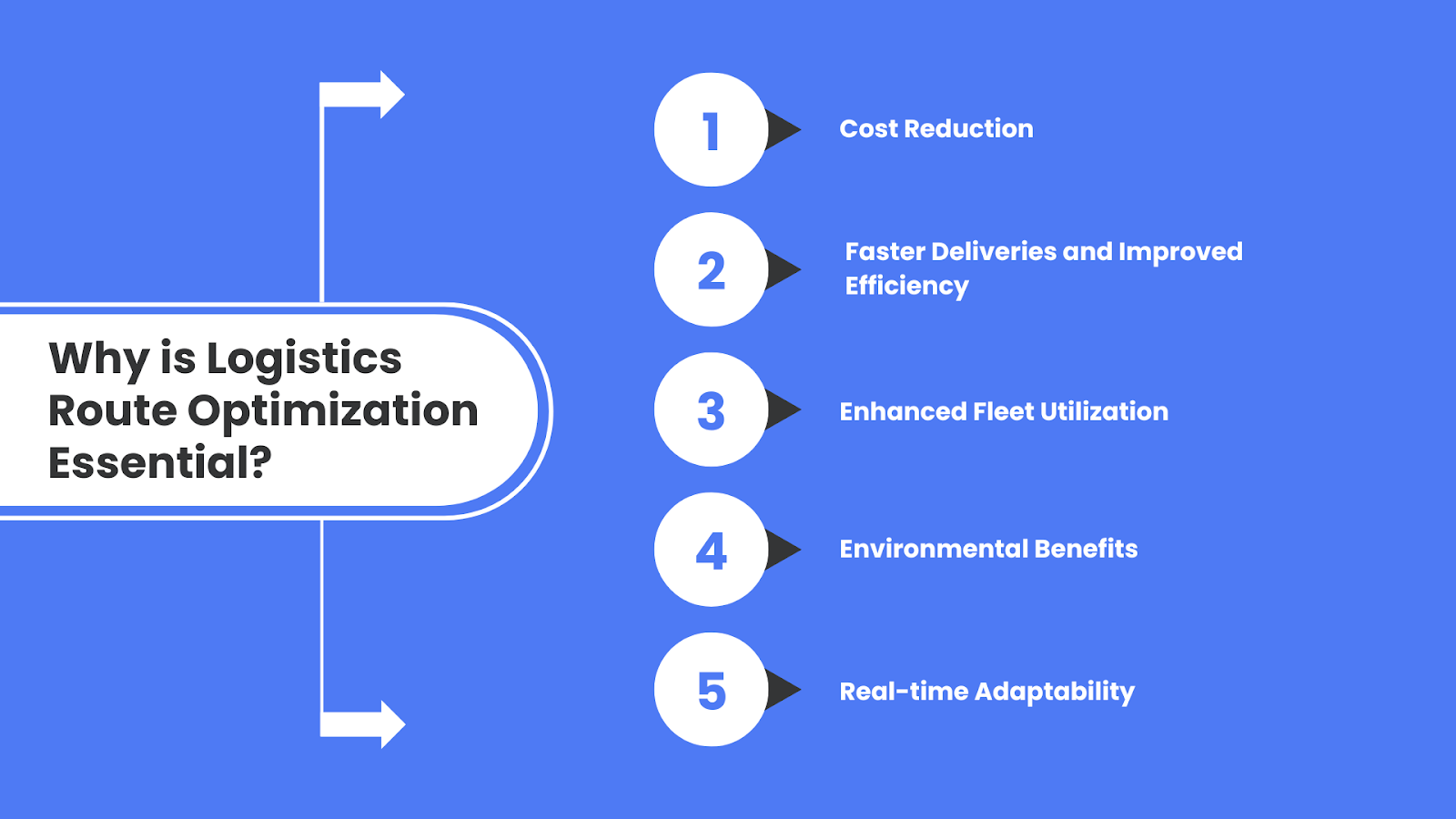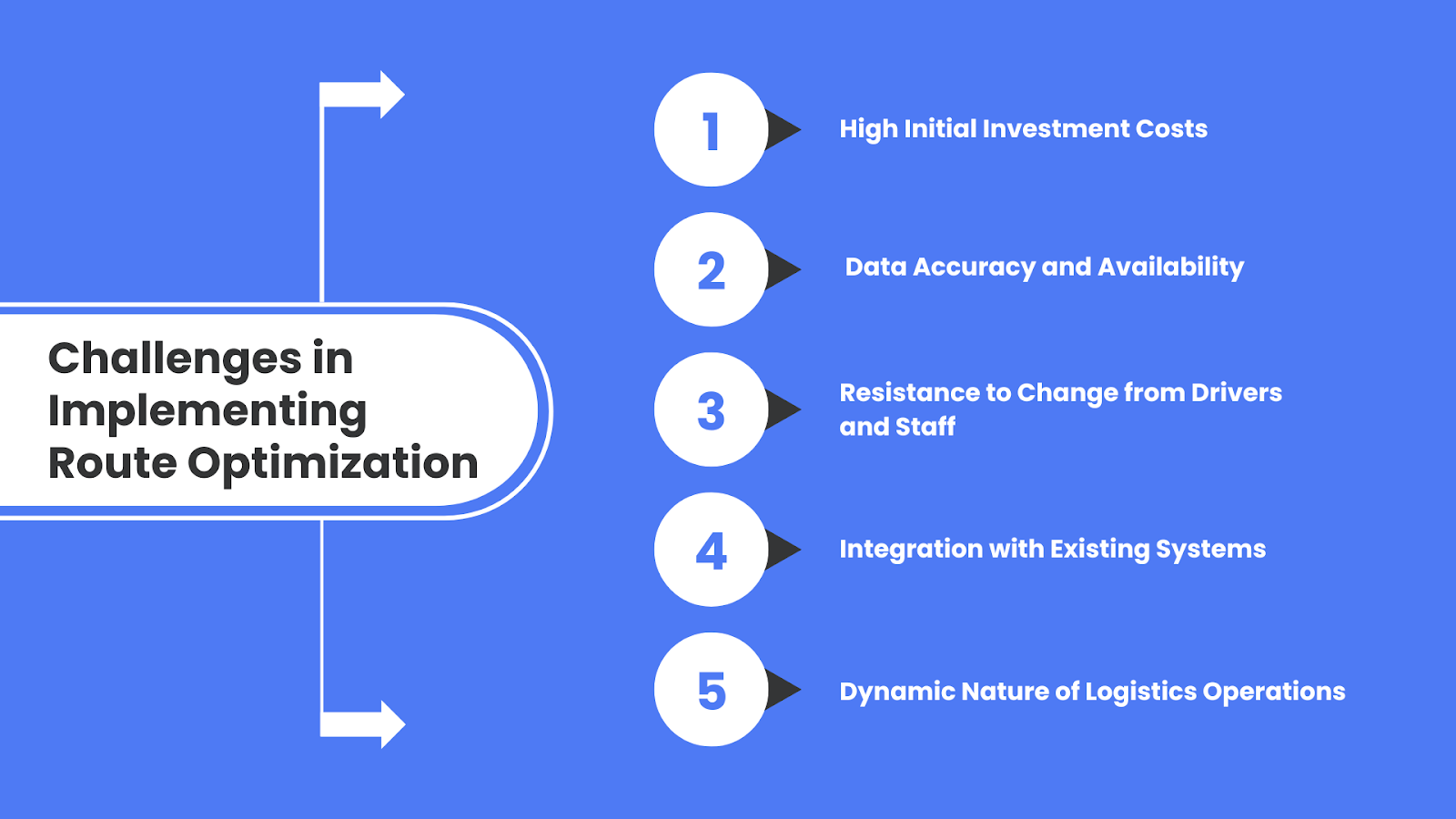
Route optimization in logistics plays an important role in streamlining supply chains and ensuring the timely delivery of goods. However, traffic congestion, rising fuel costs, and inefficiencies continue to impact profitability. Research indicates that businesses implementing route optimization strategies can achieve significant cost savings and improved delivery efficiency.
By using Artificial Intelligence (AI), advanced algorithms, and real-time data, businesses can find the most efficient routes, bypass congestion, and adapt to unforeseen delays. Studies show that optimized routing can reduce fuel consumption by 62%, greenhouse gas (GHG) emissions by 62%, and travel distance by 10% per month across various industries.
This guide explores how route optimization works, its benefits, and how businesses can implement it to enhance efficiency, cut costs, and improve customer satisfaction.
Route optimization in logistics focuses on determining the most efficient delivery routes by analyzing traffic, schedules, vehicle capacity, and fuel usage. The goal is to reduce costs, improve delivery times, and enhance fleet efficiency.
Logistics route optimization plays a crucial role in ensuring that companies meet tight deadlines, minimize fuel consumption, and maximize operational efficiency. By utilizing advanced software, businesses can plan optimal routes, reducing unnecessary delays and enhancing overall fleet performance. By understanding how route optimization enhances logistics efficiency, we can now explore why it is essential for businesses striving to reduce costs and improve operations.

Logistics route optimization significantly impacts a company’s operational costs and efficiency. Here's why it is essential:
By optimizing routes, businesses can:
Route optimization ensures:
Optimized routing helps:
Efficient routing contributes to sustainability by:
Drive sustainability in your freight operations with Freight Sustainability. Optimize routes, track emissions, and reduce your carbon footprint effortlessly.
Modern logistics face traffic congestion, weather disruptions, and last-minute changes. Logistics Route optimization enables:
Now that we understand why route optimization is vital, let’s take a closer look at how route optimization in logistics actually works.
Also Read: Switching to Green Logistics - A Guide
Route optimization goes beyond finding the shortest path - it identifies cost-effective and efficient routes while factoring in real-world variables. Modern route optimization relies on advanced technology, real-time data, and intelligent algorithms to streamline logistics operations. Here’s a step-by-step breakdown of how route optimization works:
Before optimization begins, the system gathers crucial logistics data, including:
This data is collected from various sources, such as Global Positioning Systems (GPS) trackers, weather APIs, traffic monitoring systems, and historical delivery records.
Once the data is gathered, route optimization software processes it using complex algorithms to determine the most efficient routes. These algorithms consider:
One of the biggest advantages of modern route optimization is its ability to adjust routes in real-time. Dynamic routing systems continuously monitor:
Route optimization software integrates seamlessly with Transportation Management Systems (TMS) and Fleet Management Systems (FMS) to enhance operational efficiency. These integrations help with:
This integration streamlines dispatch, tracking, and proof of delivery. Now, let’s look at the technologies powering route optimization.
Route optimization in logistics is powered by cutting-edge technology that enables businesses to plan, monitor, and adjust delivery routes with precision. From AI-driven algorithms to real-time GPS tracking, modern logistics companies rely on sophisticated tools to enhance efficiency, reduce costs, and improve customer satisfaction. In fact, AI and robotics are expected to enhance logistics productivity by more than 40% by 2035.
Here’s a breakdown of the key technologies behind route optimization:
ML and AI continuously refine route optimization by analyzing past performance. These technologies help:
GPS and telematics provide real-time tracking and vehicle monitoring, allowing logistics managers to:
GIS technology enables detailed mapping and geospatial analysis, which is essential for route optimization. It helps:
Modern route optimization tools integrate real-time traffic and weather data from multiple sources, including:
The vast amount of data required for route optimization is processed using cloud-based computing and big data analytics. This allows businesses to:
IoT technology enhances route optimization by connecting vehicles, warehouses, and delivery hubs in a smart network. Key benefits include:
Gain real-time supply chain intelligence with Freight IQ, track market dynamics, anticipate seasonal shifts, and make data-driven decisions to optimize your freight operations. While logistics route optimization offers many benefits, some challenges need to be addressed for successful implementation. Let’s explore the obstacles businesses may face in adopting route optimization.
Also Read: 6 Strategies for Advancing Digital Maturity in Logistics

While route optimization in logistics offers significant benefits, implementing it comes with several challenges. Businesses must overcome technical, operational, and financial hurdles to ensure a seamless and efficient routing system.
Here are the key challenges faced during route optimization implementation:
Deploying advanced route optimization software requires significant upfront investment in technology, infrastructure, and training. Small and mid-sized businesses may find it difficult to afford AI-powered systems, GPS tracking, and real-time traffic monitoring tools. Costs associated with system integration, software licensing, and regular updates can add to the overall expenditure.
Route optimization in logistics relies on real-time traffic data, weather conditions, and road restrictions. If this data is inaccurate or outdated, it can lead to inefficient routing decisions. Poorly mapped delivery locations, missing address details, and incorrect geocoding can disrupt the optimization process. In rural and remote areas, a lack of proper mapping and real-time traffic updates can create routing inefficiencies.
Logistics teams and drivers may be reluctant to adopt new technology, preferring traditional routing methods. Resistance to automation may stem from concerns over job security, additional workload, or difficulty in using digital tools. Lack of proper training can result in underutilization of route optimization software, reducing its effectiveness.
Many businesses already use Transportation Management Systems (TMS), Fleet Management Systems (FMS), and Enterprise Resource Planning (ERP) solutions. Ensuring seamless integration between these systems and route optimization software can be complex. Poor integration can result in data silos, inefficiencies, and compatibility issues that affect decision-making.
Unexpected delays such as traffic congestion, road closures, vehicle breakdowns, and last-minute order changes make real-time route adjustments necessary. Traditional route optimization models struggle to handle real-time rerouting, requiring AI-driven solutions for better adaptability. Handling multi-stop deliveries, different vehicle capacities, and varying delivery windows adds another layer of complexity.
Overcoming these challenges requires a comprehensive approach to freight management that enhances visibility, automates workflows, and optimizes freight movement. FreightFox helps businesses streamline operations with real-time tracking, seamless system integration, and data-driven decision-making, turning logistics complexities into operational efficiencies.
Route optimization in logistics is revolutionizing multiple industries by enabling businesses to reduce delivery times, lower costs, and enhance overall efficiency. From e-commerce to healthcare, industries that rely on transportation and logistics are increasingly adopting route optimization to improve their operations.
With the rise of online shopping, efficient delivery management is crucial for e-commerce and retail businesses. Route optimization helps by:
Speed is the most critical factor in food delivery and quick commerce (10-minute grocery delivery services). Route optimization benefits this sector by:
Logistics companies rely on route optimization to streamline deliveries by:
In healthcare, timely delivery of medical supplies, vaccines, and emergency aid is crucial. Route optimization ensures:
Companies providing repair, installation, and maintenance services benefit from optimized route planning by:
Route optimization isn’t just about cutting costs, it’s about smarter logistics, faster deliveries, and happier customers. By using AI-driven algorithms, real-time data, and intelligent routing, businesses can minimize delays, maximize fleet productivity, and streamline operations. Optimized routing also reduces fuel consumption and emissions, making logistics both cost-effective and sustainable.
Challenges in implementation? With the right technology and a data-driven approach, businesses can transform their logistics operations and gain a competitive edge. FreightFox simplifies freight management by providing real-time visibility, intelligent routing, and seamless coordination, helping businesses manage complexities and optimize their operations. Want to see how it works? Book a demo today!